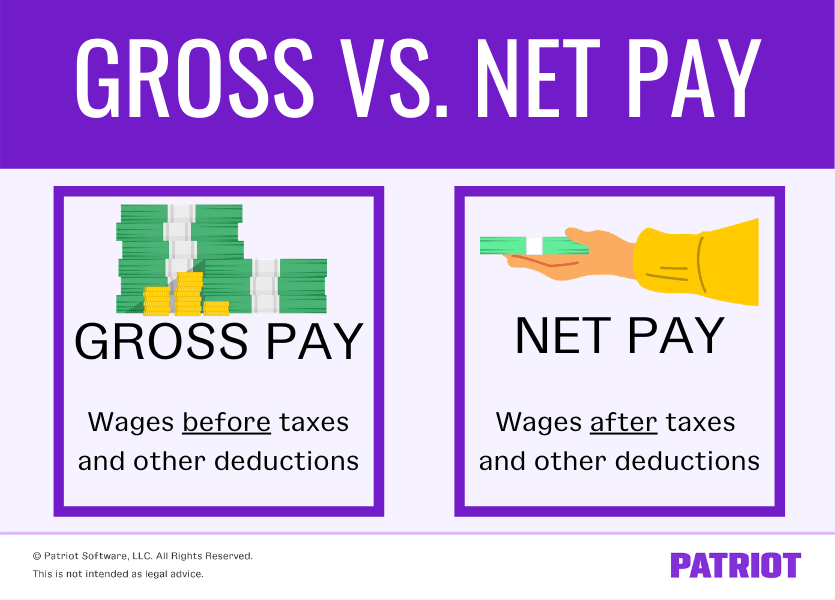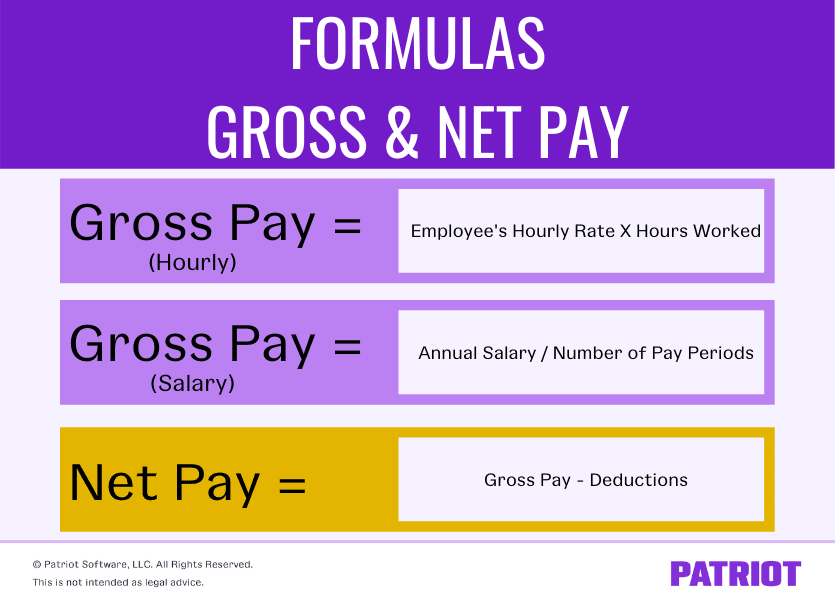Working payroll could be complicated. Though it’s pure to have payroll questions when beginning out, you may’t afford to get tripped up on the subject of gross vs. web pay. Figuring out the distinction between gross and web pay impacts worker wages, payroll withholdings, recordkeeping, and even employer legal guidelines.
Be taught gross pay vs. web pay, find out how to discover each sorts of wages, and the place to file gross and web pay.
Gross vs. web pay
Each gross and web pay take care of what your worker earns for his or her work at your small business. However, the distinction between gross vs. web pay comes right down to once you withhold deductions.
Payroll deductions embrace federal, state, and native revenue tax; Social Safety tax; and Medicare tax. Non-tax deductions embrace medical insurance premiums, retirement plan contributions, and wage garnishments.
Gross pay is the quantity you owe staff earlier than withholding taxes and different deductions. Gross pay isn’t the quantity you pay your worker. You need to use gross wages to calculate your staff’ web wages.
Web pay is what an worker takes residence after deductions. Web pay is the quantity you give to your worker. An worker’s web wages could be considerably lower than their gross wages as a consequence of necessary and voluntary payroll deductions.

Gross pay is the sticker value that draws staff to your small business, however web pay is what the worker receives and has to spend.
You need to decide an worker’s gross pay, deductions, and web wages every pay interval. Frequent pay frequencies embrace weekly, biweekly, semimonthly, and month-to-month. You’ll be able to even calculate an worker’s annual gross and web wages.
Gross pay vs. web pay: Formulation
To seek out gross pay, calculate the worker’s wages earlier than deductions. For web pay, calculate the worker’s wages after deductions. Use the next formulation to assist.

Gross pay
The way you calculate gross pay is determined by whether or not the worker is an hourly or wage employee.
Hourly staff
While you rent hourly staff, you pay them an hourly charge. To seek out an hourly worker’s gross wages, multiply their hourly charge by the variety of hours labored in the course of the pay interval.
Gross Pay (Hourly) = Worker’s Hourly Charge X Hours Labored
For instance, you pay a full-time worker an hourly charge of $12. To calculate the worker’s gross pay throughout a biweekly pay interval, multiply their hourly charge by 80 hours labored. The worker’s biweekly gross wages are $960 ($12 X 80).
Wage staff
You may additionally want to find out a salaried worker’s gross wages throughout a pay interval. To seek out their gross wages, divide the worker’s annual wage by the variety of pay intervals within the 12 months.
Gross Pay (Wage) = Annual Wage / Variety of Pay Intervals
Let’s say you pay an worker a wage of $35,000 per 12 months. You utilize the semimonthly pay interval, which implies you give the worker 24 paychecks per 12 months. To seek out the worker’s gross pay, divide their annual wage by 24. The worker’s semimonthly gross wages are $1,458.33 ($35,000 / 24).
Web pay
You have to know an worker’s gross pay to calculate web pay. And, it’s essential to know the worker’s gross wages to find out their tax legal responsibility. To seek out web pay, subtract deductions from the worker’s gross wages.
Web Pay = Gross Pay – Deductions
Utilizing the hourly gross wages instance above, let’s say an worker earns $960 biweekly. First, calculate their deductions. The worker doesn’t have something withheld from their pay besides federal revenue, Social Safety, and Medicare taxes.
The worker is single, so their federal revenue tax legal responsibility is $51, (per IRS Publication 15-T). The mixed Social Safety and Medicare tax charge, generally known as FICA tax, is 7.65% of their gross wages. The worker’s FICA tax legal responsibility is $73.44 ($960 X 0.0765).
The worker’s whole deductions equal $124.44 ($73.44 + $51). Subtract $124.44 from $960 to get the worker’s web pay of $835.56. Pay the worker $835.56 and remit the deductions to the IRS.
The place to file gross and web wage
You need to preserve payroll paperwork containing gross and web pay info in your data for not less than three years. Document gross and web wages on pay stubs and in your payroll register.
Pay stubs
Pay stubs listing particulars about every worker’s pay, together with their gross wages, deductions, and web wages.
For every payroll you run, it is best to create and distribute pay stubs for every worker. Relying on the place your small business and staff are positioned, you may be required to provide your staff a bodily or digital pay stub.
Pay stubs additionally present the worker’s year-to-date payroll. You and your worker can reference year-to-date paycheck stubs to find out the entire quantity of gross wages, deductions, and web wages for the 12 months.
Workers can seek the advice of pay stubs if they’ve considerations in regards to the distinction between gross and web pay. And, you may view pay stubs to confirm payroll accuracy.
Payroll register
Like a pay stub, a payroll register lists gross pay, deductions, and web pay. Nevertheless, a payroll register is a file of payroll particulars for all of your staff. Payroll registers are to your data, not for distribution to staff.
Payroll registers embrace details about particular person staff, much like pay stubs. On the finish, the payroll register provides up gross wages, deductions, and web wages to provide you totals.
Payroll registers present you the entire gross wages your small business pays throughout a interval. And, they present you the way a lot you withheld for taxes and different deductions. The web pay listed on the payroll register reveals you the way a lot you paid staff via direct deposit, examine, or money.
Why understanding web vs. gross revenue issues
To run payroll accurately, it’s essential to know the distinction between gross and web pay. For those who don’t withhold taxes from gross wages, you might be paying staff below the desk.
Understanding gross vs. web pay can also be crucial for when staff have questions on their earnings. An worker who was provided a sure gross pay may be stunned once they obtain their web pay. You’ll be able to clarify the distinction between gross and web wages to the worker.
You need to additionally perceive gross pay vs. web pay when you promise an worker a sure take-home pay. You’ll be able to gross up payroll so the worker’s take-home pay is the sticker value you provided. A gross-up is once you improve the worker’s gross wages to account for his or her tax legal responsibility.
On the lookout for a straightforward solution to calculate your staff’ gross and web wages? Patriot’s on-line payroll software program enables you to run payroll in three straightforward steps. And, our payroll register report reveals all cost particulars for every worker. Get your free trial at the moment!
This text has been up to date from its authentic publication date of September 24, 2018.
This isn’t meant as authorized recommendation; for extra info, please click on right here.



